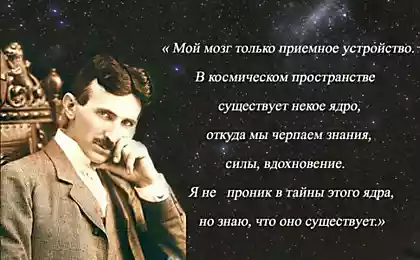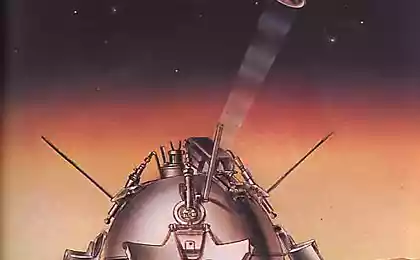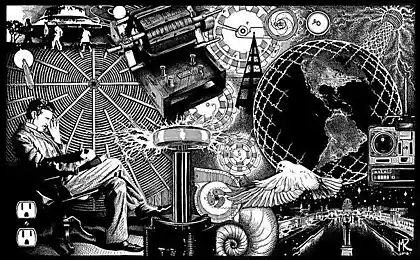625
10 stupid attempts to prove the existence of aliens
Thirty five million seven hundred forty seven thousand three hundred ninety eight
Is there life elsewhere in the Universe? Becoming increasingly likely that life must have found another shelter. Yes, she may be too far for communication. Yes, we may not know it at the meeting. Theories about the existence of extraterrestrial life near us ranged from misguided to downright stupid.
As the Vikings were looking for life on Марсе
In the 70-ies of the landers NASA Viking probed Martian soil, eagerly looking for signs of life on the red planet. Although they found no actual microorganisms, the collected samples had traces of carbon dioxide. Some scientists studied the results and concluded that living organisms were once on the planet and made these connections.
The findings were disputed for many decades. Not long ago, scientists came to the conclusion that the iron particles present in the Martian soil (which is red), can be oxidized by compounds of carbon that are naturally present in it.
Although these "Viking" and does not indicate the presence of Martian soil carbon may indicate that once life on the planet still existed. Today's studies are focused mostly not on the search for living organisms, and on the study of could the atmosphere of Mars to preserve traces of life even after a long period of time.
Arthur C. Clarke and Mars растительность
Famous sci-Fi author and screenwriter Arthur C. Clarke long believed in life on Mars. In 2001, Clarke downloaded several photos from NASA taken with Mars Global Surveyor, and somehow saw them on the trees.
Clark collected men in his house in Sri Lanka, and showed them the pictures with comments. Clark said, "I'm very serious when I look at these new pictures of Mars. Something is actually moving and changing depending on the time of year that requires a minimum of vegetation". In another interview, he joked: "I am Now convinced that Mars is inhabited by a race of crazy landscape gardeners".
In fact, the shots were simply sand dunes, covered with frozen carbon dioxide. Over time, dark sand strode down the dunes, leaving streaks that could be mistaken for the trees if you have a vivid imagination.
Crazy experiments in connection with марсианами
In 1820, German mathematician Carl Friedrich Gauss decided to include the work of Pythagoras in its plans for communication with alien life on Mars. Gauss had proposed to clear a large area in Siberia and to sow it with wheat in the form, geometrically illustrating the Pythagorean theorem. After harvest, the bright yellow crop area would contrast with the dark color of the forest. Gauss thought that Martian observers could spot this gigantic triangle on Earth with a small telescope.
In the 19th century were popular, and other strange ideas. Astronomer Joseph Littrow proposed to dig a 30-kilometer trench in different geometric shapes throughout the Sahara. Then fill them with kerosene and set on fire. The Frenchman Charles CROs, proposed to build a large mirror that can collect sunlight and to burn the message on the surface of Mars.
Martian contacts Nikola Теслы
Nikola Tesla was one of the most brilliant scientists in the history of mankind, but he openly lied, claiming to have received artificial signals of extraterrestrial origin. He said that the signals came from Mars or Venus. However, this is not the only strange act of the Tesla.
In a letter to the New York Times, Tesla wrote of how Mars can support life. He studied the distance of the planets to the Sun from the point of view of evolution. Venus was at a young age and could not support humanoid life. The earth was in a Mature state. Mars has already achieved old age, but has passed the basic biological and technological evolution stage.
Tesla suggested ways of improving our means of communication with Mars, first by moving our observatories to send a clean signal through the atmosphere. In 1937, Tesla's work led him to believe that he can win the prize of the Pierre Guzman 100 000 francs as "the first person who will find a way to connect with the star and get the answer". Contest rules exclude contacts with Mars, because it "would be too easy."
No one could certainly verify the observation of Tesla, but he probably actually found the pulsation of distant stars. It was far from transmission of intelligent messages, which said a scientist, but can be considered quite an impressive achievement.
Jupiter and its луны
In the past, Jupiter was considered the most likely candidate for finding extraterrestrial life — at least, compared to other gas giants in our Solar system. It was known that its outer atmosphere is cold enough to instantly freeze all life, and the methane and ammonia on the surface can kill as fast, but some scholars insisted that the two regions may be fertile area.
It was believed that part of its atmosphere can support life — floating and slow-moving organisms like flying jellyfish. These hypothetical creatures can't develop either in a high-altitude cold zones, to go down too low. However, not so long ago, it was confirmed that the existence of such organisms is extremely unlikely.
But the satellites of Jupiter appear to be the most promising places in the Solar system to sustain extraterrestrial life, and many theories say that life could exist on them to this day. Ganymede, the largest moon of Jupiter can support salt water between layers of ice. Europe and is inhabited by alien organisms that hide in an underground ocean under the moving ice satellites.
IO, the closest large satellite to Jupiter, has slightly lost points in comparison with its neighbors. It constantly bombards deadly radiation. However, the possibility of life on IO are not completely excluded. Perhaps, IO contained liquid water billions of years ago. And if in this water bred germs, they could go deep into the moon and survive all the destructive consequences for them.
Life on Титане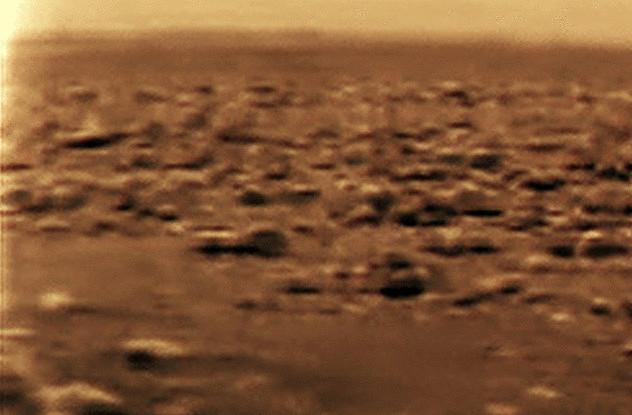
In June 2010, the NASA probe Cassini has discovered that Titan, one of the many satellites of Saturn, has an extremely dense atmosphere. Two further studies have raised many questions about the nature of Titan. The first, published in the journal Icarus, has shown that traces of hydrogen from the atmosphere of Saturn's disappearing on Titan's surface. Another, from the journal of Geographic Research, said the surprisingly low level of hydrocarbon of the acetylene on the moon's surface.
NASA has proposed several possible explanations. The catalyst on the surface of the moon can convert hydrogen and acetylene into methane. Sunlight and cosmic rays may also be responsible for the disappearance of chemical substances. But the most interesting explanation — biological, say, breathing organisms consume hydrogen and acetylene. Such a body would be absolutely new, not having analogues on Earth. Life based on methane have not been found.
NASA scientists, who hinted at methane life, said that we have no evidence of this option. This is just one of several possible explanations. But that did not stop the media to quote NASA, saying that "on Saturn there is alien life."
Estimated lander, the Titan Mare Explorer, which will help to find the answer to the methane mystery of Titan, is still in development.
Aliens Плутона
In 2011, astrophysics ed Turner and AVI Loeb discussed the incident at Fukushima, which gave a good lesson to use electricity to people in Tokyo. The bright lights of the town replaced by the dim after the disaster and subsequent reductions of energy supply. Turner and Loeb argued that such drastic changes will be visible to observers, which are 30 times farther than Pluto.
The proposed Large SYNOPTIC survey telescope will photograph the entire night sky for a few days or so. The changing light of the heavenly bodies are easily visible. Scientists suggest that in coming decades we will be able to see for sure whether the light of Pluto is a reflection of the Sun or by artificial sources on the surface of the dwarf planet, which can be a normal planet again.
A continuation of these studies, of course, the theory that life can nest inside of Pluto. Scientists have suggested that the presence of tectonic activity on Pluto would imply the presence of warm underground ocean — a possible habitat for life. Former planet moon Charon may also have similar characteristics. After the probe "New horizons" NASA will make the first images of Pluto and Charon in high resolution in 2015, we will receive specific answers.
Aliens in стратосфере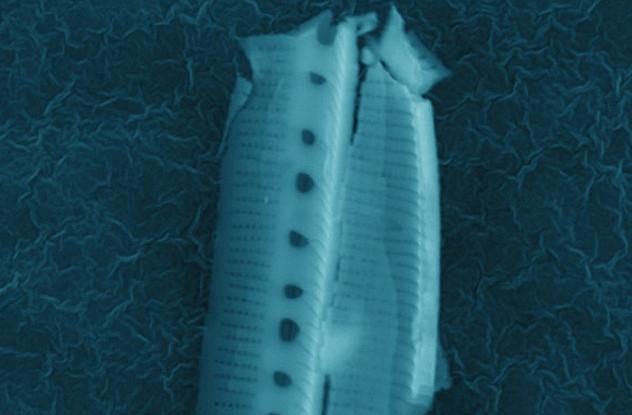
Maybe we don't have to look too far to prove that we are not alone. Extraterrestrial life may be at arm's length in the stratosphere.
During the peak of the meteor shower Perseid August 12, 2013, astrobiologists from the University of Sheffield launched a balloon to a height of 27 kilometres into the stratosphere. The lead scientist of the project, the Milton Wainwright was surprised by the results, claiming back the ball came back with traces of extraterrestrial life. Wainwright said that the particles were too heavy to their place of birth was the surface of the Earth. So they are definitely extraterrestrial.
Skeptics definitely put the study into question. These messages early definitely turned out to be erroneous. Trust Wainwright also questioned, as he believes in the theory of panspermia — extraterrestrial origin of biological life by registering her for the meteor. Beliefs Wainwright may have confused his research, and the scientist himself was wishful thinking.
50 billion Venusians Thomas Дика
In the 1830-ies of the Scottish Minister and Amateur astronomer Thomas dick decided to calculate the exact number of inhabitants in our Solar system. Dick suggested that all celestial bodies are inhabited with life, and his interplanetary census was taken the population of the UK at the time. In short, the scientist decided that Venus is home to 50 billion.
Dick allowed himself to make a more bold statement. Live on Mars 15 billion Martians on Jupiter — a few trillion of jupiterian, on Saturn — on the order of eight trillion Saturnian, and in General, only some of the rings of Saturn, not counting the planet.
In the Solar system dick counted about 22 trillion beings, not counting the Sun, which could accommodate 31 times-more than any of the creatures.
Соларианцы
In addition to Thomas dick and others thought that the Sun is inhabited. (Apparently, out they go out at night when it's dark). In 1440, a theologian and mathematician Nicholas of Cusa wrote about the place in the Sun inhabited "solar beings, bright and enlightened intellectual denizens". These creatures were supposed to be more spiritual compared to those who lived on the moon (lunatics). Cusa is not burned at the stake and not excommunicated for believing in aliens. Years later he became a cardinal.
The early Mormon leaders like Brigham young were held to similar theories. Young claimed that the Sun obviously occupied, since "it was not done in vain; it was made to give light to those who live on other planets."
Source: hi-news.ru
Is there life elsewhere in the Universe? Becoming increasingly likely that life must have found another shelter. Yes, she may be too far for communication. Yes, we may not know it at the meeting. Theories about the existence of extraterrestrial life near us ranged from misguided to downright stupid.
As the Vikings were looking for life on Марсе

In the 70-ies of the landers NASA Viking probed Martian soil, eagerly looking for signs of life on the red planet. Although they found no actual microorganisms, the collected samples had traces of carbon dioxide. Some scientists studied the results and concluded that living organisms were once on the planet and made these connections.
The findings were disputed for many decades. Not long ago, scientists came to the conclusion that the iron particles present in the Martian soil (which is red), can be oxidized by compounds of carbon that are naturally present in it.
Although these "Viking" and does not indicate the presence of Martian soil carbon may indicate that once life on the planet still existed. Today's studies are focused mostly not on the search for living organisms, and on the study of could the atmosphere of Mars to preserve traces of life even after a long period of time.
Arthur C. Clarke and Mars растительность

Famous sci-Fi author and screenwriter Arthur C. Clarke long believed in life on Mars. In 2001, Clarke downloaded several photos from NASA taken with Mars Global Surveyor, and somehow saw them on the trees.
Clark collected men in his house in Sri Lanka, and showed them the pictures with comments. Clark said, "I'm very serious when I look at these new pictures of Mars. Something is actually moving and changing depending on the time of year that requires a minimum of vegetation". In another interview, he joked: "I am Now convinced that Mars is inhabited by a race of crazy landscape gardeners".
In fact, the shots were simply sand dunes, covered with frozen carbon dioxide. Over time, dark sand strode down the dunes, leaving streaks that could be mistaken for the trees if you have a vivid imagination.
Crazy experiments in connection with марсианами

In 1820, German mathematician Carl Friedrich Gauss decided to include the work of Pythagoras in its plans for communication with alien life on Mars. Gauss had proposed to clear a large area in Siberia and to sow it with wheat in the form, geometrically illustrating the Pythagorean theorem. After harvest, the bright yellow crop area would contrast with the dark color of the forest. Gauss thought that Martian observers could spot this gigantic triangle on Earth with a small telescope.
In the 19th century were popular, and other strange ideas. Astronomer Joseph Littrow proposed to dig a 30-kilometer trench in different geometric shapes throughout the Sahara. Then fill them with kerosene and set on fire. The Frenchman Charles CROs, proposed to build a large mirror that can collect sunlight and to burn the message on the surface of Mars.
Martian contacts Nikola Теслы

Nikola Tesla was one of the most brilliant scientists in the history of mankind, but he openly lied, claiming to have received artificial signals of extraterrestrial origin. He said that the signals came from Mars or Venus. However, this is not the only strange act of the Tesla.
In a letter to the New York Times, Tesla wrote of how Mars can support life. He studied the distance of the planets to the Sun from the point of view of evolution. Venus was at a young age and could not support humanoid life. The earth was in a Mature state. Mars has already achieved old age, but has passed the basic biological and technological evolution stage.
Tesla suggested ways of improving our means of communication with Mars, first by moving our observatories to send a clean signal through the atmosphere. In 1937, Tesla's work led him to believe that he can win the prize of the Pierre Guzman 100 000 francs as "the first person who will find a way to connect with the star and get the answer". Contest rules exclude contacts with Mars, because it "would be too easy."
No one could certainly verify the observation of Tesla, but he probably actually found the pulsation of distant stars. It was far from transmission of intelligent messages, which said a scientist, but can be considered quite an impressive achievement.
Jupiter and its луны

In the past, Jupiter was considered the most likely candidate for finding extraterrestrial life — at least, compared to other gas giants in our Solar system. It was known that its outer atmosphere is cold enough to instantly freeze all life, and the methane and ammonia on the surface can kill as fast, but some scholars insisted that the two regions may be fertile area.
It was believed that part of its atmosphere can support life — floating and slow-moving organisms like flying jellyfish. These hypothetical creatures can't develop either in a high-altitude cold zones, to go down too low. However, not so long ago, it was confirmed that the existence of such organisms is extremely unlikely.
But the satellites of Jupiter appear to be the most promising places in the Solar system to sustain extraterrestrial life, and many theories say that life could exist on them to this day. Ganymede, the largest moon of Jupiter can support salt water between layers of ice. Europe and is inhabited by alien organisms that hide in an underground ocean under the moving ice satellites.
IO, the closest large satellite to Jupiter, has slightly lost points in comparison with its neighbors. It constantly bombards deadly radiation. However, the possibility of life on IO are not completely excluded. Perhaps, IO contained liquid water billions of years ago. And if in this water bred germs, they could go deep into the moon and survive all the destructive consequences for them.
Life on Титане

In June 2010, the NASA probe Cassini has discovered that Titan, one of the many satellites of Saturn, has an extremely dense atmosphere. Two further studies have raised many questions about the nature of Titan. The first, published in the journal Icarus, has shown that traces of hydrogen from the atmosphere of Saturn's disappearing on Titan's surface. Another, from the journal of Geographic Research, said the surprisingly low level of hydrocarbon of the acetylene on the moon's surface.
NASA has proposed several possible explanations. The catalyst on the surface of the moon can convert hydrogen and acetylene into methane. Sunlight and cosmic rays may also be responsible for the disappearance of chemical substances. But the most interesting explanation — biological, say, breathing organisms consume hydrogen and acetylene. Such a body would be absolutely new, not having analogues on Earth. Life based on methane have not been found.
NASA scientists, who hinted at methane life, said that we have no evidence of this option. This is just one of several possible explanations. But that did not stop the media to quote NASA, saying that "on Saturn there is alien life."
Estimated lander, the Titan Mare Explorer, which will help to find the answer to the methane mystery of Titan, is still in development.
Aliens Плутона

In 2011, astrophysics ed Turner and AVI Loeb discussed the incident at Fukushima, which gave a good lesson to use electricity to people in Tokyo. The bright lights of the town replaced by the dim after the disaster and subsequent reductions of energy supply. Turner and Loeb argued that such drastic changes will be visible to observers, which are 30 times farther than Pluto.
The proposed Large SYNOPTIC survey telescope will photograph the entire night sky for a few days or so. The changing light of the heavenly bodies are easily visible. Scientists suggest that in coming decades we will be able to see for sure whether the light of Pluto is a reflection of the Sun or by artificial sources on the surface of the dwarf planet, which can be a normal planet again.
A continuation of these studies, of course, the theory that life can nest inside of Pluto. Scientists have suggested that the presence of tectonic activity on Pluto would imply the presence of warm underground ocean — a possible habitat for life. Former planet moon Charon may also have similar characteristics. After the probe "New horizons" NASA will make the first images of Pluto and Charon in high resolution in 2015, we will receive specific answers.
Aliens in стратосфере

Maybe we don't have to look too far to prove that we are not alone. Extraterrestrial life may be at arm's length in the stratosphere.
During the peak of the meteor shower Perseid August 12, 2013, astrobiologists from the University of Sheffield launched a balloon to a height of 27 kilometres into the stratosphere. The lead scientist of the project, the Milton Wainwright was surprised by the results, claiming back the ball came back with traces of extraterrestrial life. Wainwright said that the particles were too heavy to their place of birth was the surface of the Earth. So they are definitely extraterrestrial.
Skeptics definitely put the study into question. These messages early definitely turned out to be erroneous. Trust Wainwright also questioned, as he believes in the theory of panspermia — extraterrestrial origin of biological life by registering her for the meteor. Beliefs Wainwright may have confused his research, and the scientist himself was wishful thinking.
50 billion Venusians Thomas Дика

In the 1830-ies of the Scottish Minister and Amateur astronomer Thomas dick decided to calculate the exact number of inhabitants in our Solar system. Dick suggested that all celestial bodies are inhabited with life, and his interplanetary census was taken the population of the UK at the time. In short, the scientist decided that Venus is home to 50 billion.
Dick allowed himself to make a more bold statement. Live on Mars 15 billion Martians on Jupiter — a few trillion of jupiterian, on Saturn — on the order of eight trillion Saturnian, and in General, only some of the rings of Saturn, not counting the planet.
In the Solar system dick counted about 22 trillion beings, not counting the Sun, which could accommodate 31 times-more than any of the creatures.
Соларианцы

In addition to Thomas dick and others thought that the Sun is inhabited. (Apparently, out they go out at night when it's dark). In 1440, a theologian and mathematician Nicholas of Cusa wrote about the place in the Sun inhabited "solar beings, bright and enlightened intellectual denizens". These creatures were supposed to be more spiritual compared to those who lived on the moon (lunatics). Cusa is not burned at the stake and not excommunicated for believing in aliens. Years later he became a cardinal.
The early Mormon leaders like Brigham young were held to similar theories. Young claimed that the Sun obviously occupied, since "it was not done in vain; it was made to give light to those who live on other planets."
Source: hi-news.ru
